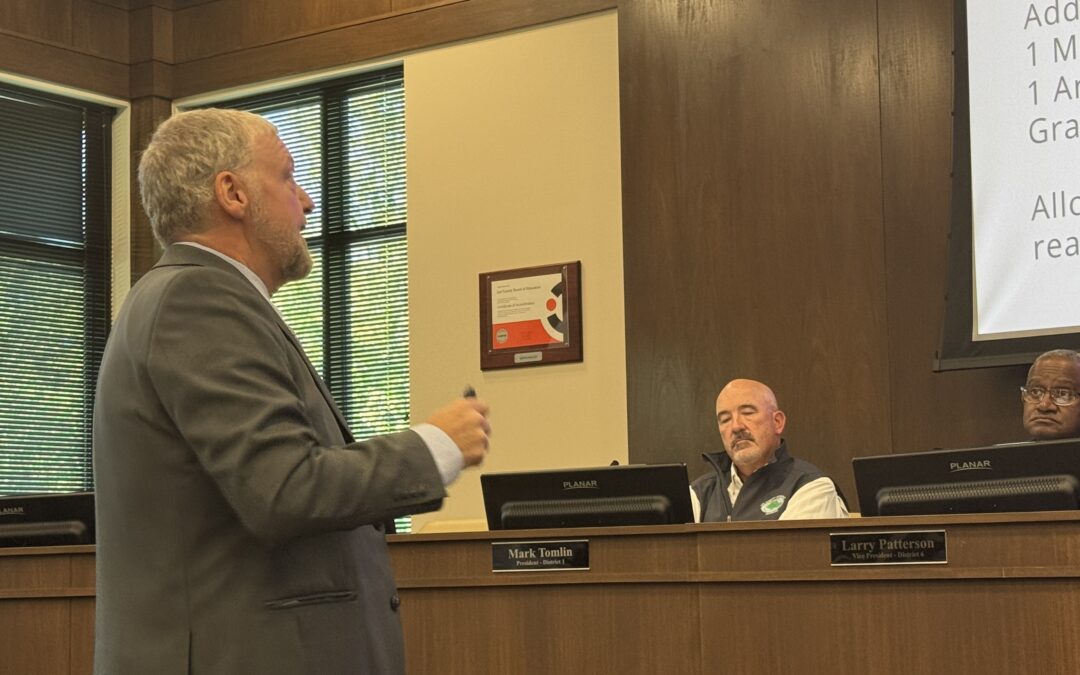BY STEVEN STIEFEL
FOR THE OBSERVER
LEE COUNTY — The Lee County Board of Education is facing major changes following a work session last week where officials discussed major declines in student enrollment.
The Board is in an untenable position due to a decade of student population decline, creating budget shortfalls and a school configuration that violates federal law. The board was presented with several drastic solutions and must now provide direction on which path to pursue.
Lee County enrollment decreased by 1,226 students since 2007, lowering from 9,745 to 8,519. Superintendent Mike Howard attributed the drop in student population to the COVID-19 pandemic, as well as migrations to private schools resulting from 2024 changes made by the Alabama Legislature to create the Alabama’s Creating Hope and Opportunity for our Students’ Education (CHOOSE) Act program, which provides parents a credit that is placed into an education savings account allowing parents to direct funds to pay for private school tuition and fees.
The district must address a $4.16 million budget shortfall, but any cuts are legally blocked without a two-year redistricting process to ensure equity. A decision on which alternative to choose must be made by the November meeting to have adequate time to make adjustments.
Smiths Station Elementary schools have 154 certified staff, paid for by state, federal and local funds. Based on 2025 numbers, those schools are overstaffed by 30 certified units, costing approximately $2.5 million. Those numbers must be reduced by 21 units starting next year.
“The truth we need to have 49 cuts that would save $4.16 million. Ideally, we’re going to do 30 of them,” Howard said. “Thirty is $2.5 million. If we’re going to distribute that evenly, K-12, we have to come up with $2.5 million in cuts across the board to make an even distribution so we’re not violating federal law.”
As things stand, the District would need to slash art and music programs, as well as robotics classes and dual enrollment in high school. They would also need to cut locally-funded professional development programs across the entire county. Football programs would likely change classification from 7A to 4A. Some communities might also need a tax increase to make up for revenues redirected elsewhere. Classrooms would also see more students in each one.
Even with the proposed sports and program eliminations, a shortfall of $228,000 would remain, and these cuts would be required annually.
Howard said that applying budget cuts unequally across schools could violate federal laws (14th Amendment, Section 504, Title VI), potentially leading to a Department of Justice takeover.
“Changes have to happen, because we have issues with federal law coming up,” said Howard. “Civil rights law states that title schools, which all of these are, cannot have inequality, within themselves. That’s called comparability of services. We’re talking about the same community not getting the same access to education. That’s why I’m concerned, because I cannot purposely violate federal law, or go to jail, and then DOJ will come in and take over. The 14th Amendment states we cannot create inequitable schools. If one has robotics gone, guess what’s going to have to happen?”
“We’re violating, or will violate, three federal laws,” Howard said. “We are going to have to redraw all the lines. Because we’ve got to have an equal number of kids at each one of the four schools that have to have equal access to the materials they have.”
The District’s attorney must analyze the distribution of minority, poverty and special education students to ensure balance between the two proposed schools. Howard said the district must be very deliberate in how lines are drawn going forward to balance programming.
“We’ve got to make sure that when we draw the lines, they’re not just for the fun of drawing a line at this place,” he said. “We have to monitor every single household to see who’s poverty, who’s minority, who’s special ed, and make sure that we evenly distribute that. So here’s the thing. If we stay the way we are, we have to change no matter what. There’s change coming regardless. I don’t care if we stay four neighborhood schools. I really have no heartburn about that. But it’s going to cause more of a disruption doing some other options. And this staying the way we are. But this takes two years to do.”
Howard presented various options for dealing with the drop in enrollment, including Option Six, a strategic solution for grade-level model (e.g., K-2 and 3-5 schools) that would eliminate all school boundary lines. A major advantage of this would be removing the need for complex and continuous annual redrawing of district lines to maintain legal compliance.
Option Six, the three grade-level school model, is the top recommendation to resolve student imbalance and avoid federal violations, as it is the least disruptive and fastest solution, according to Howard.
Howard said Option Six restructuring would allow for additional administrative staff, reading coaches and math coaches, as well as one music and art teacher per school. Grade level resources would be in one location rather than scattered across neighborhoods. Additionally, students would be able to stay together throughout primary school rather than mixing in junior high. The challenges include a greater driving distance for parents who take their kids to school, relocating staff and retrofitting facilities such as toilets.
The discussion was noted as a difficult, logic-based decision facing emotional public opposition. It will require a major adjustment in creating grade-level schools, implementing a complex busing plan and redrawing boundaries, though officials stressed no decision has yet been made. The board must provide a final decision on the proposed consolidation plan before Thanksgiving; otherwise, the district will default to the complex and disruptive process of redrawing all boundary lines.
Administration will survey staff on their school and grade level preferences for the potential relocation.
During the regular meeting, the Board nominated Chante Ruffin of Alexander City to be the Alabama Association of School Boards District Four director. They also held an executive session to discuss a student matter. Also, Daisy Benford was recognized as District 4 Alabama Association of Middle School Principals Assistant Principal of the Year.
The next School Board meeting is Nov. 18 at 5 p.m. at the Central Office at 2410 Society Hill Road in Opelika.


